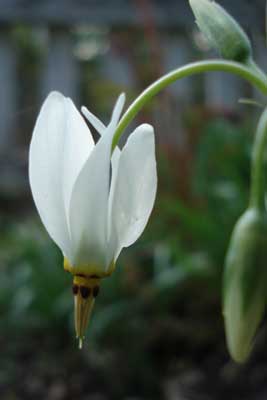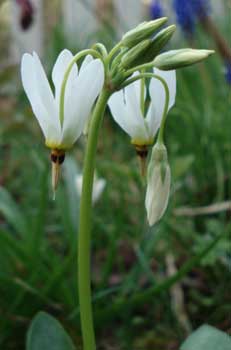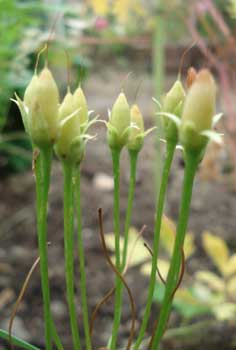
White Shooting Star
"Swept long processions here & there
Of shooting-star flowers, rosy-stole."
from 'A Prairie Idyl'
by Amanda Theodocia Jones
(1835-1914)
The first time I planted any white shooting stars (Dodecatheon meadia), when the leaves popped up their second spring, these turned out to be a favorite of the snails. It did just awful in the very shady spot I'd chosen for it, & when it didn't come back a third year, it hardly registered as mattering.by Amanda Theodocia Jones
(1835-1914)
 But that amazing comet-like April blossoms kept beckoning. The next time I planted it, I planted several, in a garden that had been treated the previous wet autumn with an organic iron phosphate slug killer.
But that amazing comet-like April blossoms kept beckoning. The next time I planted it, I planted several, in a garden that had been treated the previous wet autumn with an organic iron phosphate slug killer.I put several in a rather sunny location despite that they're often described as shade plants; their only protection from heat was taller nearby perennials. How marvelously they performed!
Shooting Star is a North American wildflower, listed as endangered in many states. But seeds of cultivated specimens are occasionally offered to gardeners, especially by shade-plant specialists. It's easily grown from seed, but it takes three years to bloom ‚ a rewarding wait for this recipient of the Award of Garden Merit.
Being native throughout the eastern half of the continent except in the far Canadian north, it has acquired many regional names throughout this extensive range. Besides Shooting Star, it is known as American Cowslip, Indian-chief, Rooster-heads, Johnny-jumps, Pride-of-Ohio, Cranesbills, Mosquito Bills, Mad Violets, Prairie Pointer, Sailor-caps, Star Shower, & Diamond Sparks.
A young plant should be placed in its permanent location in bright shade-borders or dappled sunlight, in humus-rich soil. Be sure to tag their location as they are transient in the garden & are at risk of being disturbed through digging much of the year. It requires considerable moisture in well drained soil, & if placed in a sunnier location, its water needs are still greater.
 When it goes dormant & vanishes in summer, it is no longer injurable by droughtiness, having evolved for prairie life as much as woodlands, & the prairies had very wet springs followed by hot dry summers.
When it goes dormant & vanishes in summer, it is no longer injurable by droughtiness, having evolved for prairie life as much as woodlands, & the prairies had very wet springs followed by hot dry summers.Basal leaves are quite short but the flower stem rises anywhere from eight inches to two feet. Mid-spring to late spring, it produces one-inch downward-facing white flowers, with pointed bracts sticking outward from the center forming a "beak," surrounded by radically reflexed petals. It really does look like a rocket zooming toward the Earth, or shooting star, or even a rooster's head.
Fibrous root is easily divided every few years. It should not be permitted to go to seed the year it is to be dug up & divided, so that it's energy will be expended on recovering.
The name Dodecatheon means "Twelve Gods" & alludes to it possessing multiple flowers on a single stem, looking like a cluster of meteors or comets. It was originally Pliny's name for the Primrose because the primrose was under the care of twelve Olympian gods.
The seeds surprisingly stand upright in a cluster, giving no evidence of the blooms having nodded. These pods have decorative value of their own, pear-white in June, ripening to brown. These will outlast the leaves, & when dried out at start of summer can be harvested, the seeds removed from the pods, & started in coldframes. They take two years to be ready for the open garden.
The species is named for English physician Richard Mead (1673-1754), who sat vigile with Queen Anne the day she died. His theories of contagious diseases were ahead of his time, & he was a notable humanitarian in support of healthcare for foundlings & impoverished children.
He was a proponent of outdoor exercise & had a great love of wildflowers. His friend Samuel Johnson said that Dr. Mead "lived more in the broad sunshine than almost any man," & for his famous love of flowers the North American shooting star was named in his honor.
See also the Western Shooting Star:
Dodecatheon pulchyellum